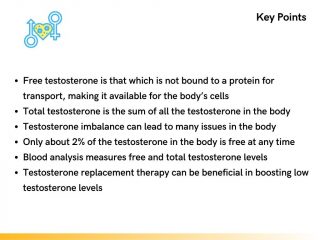
What Is Free Testosterone vs. Total Testosterone?
Testosterone is the primary male sex hormone, but it is also crucial for women. Many people do not realize that although it is one hormone, there are two primary ways it is present in the body. In this review, we examine what is free testosterone vs. total testosterone and what their levels might mean for you.
What Is Free Testosterone?
As we begin our review of total testosterone vs. free testosterone, we focus first on the testosterone available to the body’s cells. That is called free testosterone. Not all testosterone fits this category.
Free testosterone is any testosterone in the bloodstream unattached and available for the body to use. You may be wondering why all testosterone is not available, and the reason is a simple one. Testosterone is a steroid hormone that is fat-soluble, not water-soluble. That means it cannot travel freely through the bloodstream as water-soluble protein hormones do. Instead, testosterone must attach itself to a protein for transport.
There are two different proteins testosterone uses to travel through the bloodstream to its receptor cells:
- Albumin
- Sex hormone-binding globulin (SHBG)
Some differences exist between the two binding proteins. Testosterone binds tightly to SHBG, with the SHBG molecule wrapping around and encapsulating the testosterone molecules. Once SHBG-bound testosterone arrives at its targeted receptor, it must separate before becoming available to the body’s cells and tissues. Approximately 1 – 2 percent of testosterone in the bloodstream is free, with the greatest amount bound to SHBG.
The binding to albumin is not as tight, and that testosterone is bioavailable to the cells. A third test measures bioavailable testosterone – the sum of free testosterone and that which is bound to albumin. Doctors do not check this level as often as measuring free and total testosterone.
In addition to signaling testosterone receptor cells to engage their actions, free testosterone is also available to the body for conversion into dihydrotestosterone (DHT) or estradiol (estrogen). If too much testosterone is converted into one of these two hormones, a person may experience symptoms of low testosterone.
What Is Total Testosterone?
Total testosterone encompasses all testosterone in the body. In women, approximately one quarter of testosterone comes from the ovaries, one-half from peripheral tissues, and the final quarter from the adrenal glands. Males produce the majority of testosterone in the Leydig cells of the testes and a small amount in the adrenal glands.
Total testosterone is the sum of both the attached and unattached testosterone in the bloodstream. When measuring total testosterone vs. free testosterone, the total testosterone reading looks at all the testosterone in the body, both bound and unbound. Free testosterone measures only the unbound testosterone that is available for cellular uptake.
- What is the difference between free and total testosterone?
With total testosterone, the measurements let us know if the body produces enough testosterone to meet its needs.
Measuring free testosterone lets the hormone specialist know if the testosterone has trouble separating from the proteins or if an issue is present in the conversion of testosterone into estradiol or DHT.
How Does Free vs. Total Testosterone Affect Your Health?
When comparing total testosterone vs. free testosterone, we look at how changes in these levels can influence your health.
Low testosterone (free or total) can reduce crucial signals to the body’s cells. If there is not enough total testosterone, there will not be enough available freely for the cells to use. Conversely, if the testosterone cannot separate from SHBG, free testosterone levels will also be too low.
Low testosterone can lead to problems such as:

- Anemia
- Low libido
- Erectile dysfunction
- Weight gain
- Vaginal dryness
- Urinary issues
- Reduced cognitive functions
- Memory loss
- Thinning hair
- Balding
- Muscle loss
- Hot flashes
- Night sweats
- Depression
- Mood swings
- Anxiety
- Insomnia
- Stress
- Lack of energy
- Cardiovascular issues
- High cholesterol
- Bone loss and osteoporosis
- Joint pains
Higher than normal free testosterone levels can lead to oily skin, acne, and excess facial and body hair growth. High testosterone can also increase male breast size (gynecomastia) and lead to infertility. Polycystic ovarian syndrome (PCOS) may be present in women with elevated testosterone levels.
High estradiol and low testosterone levels can signal a condition called estrogen dominance. In this situation, an enzyme called aromatase from belly fat causes increased free testosterone conversion into estradiol. That conversion prohibits the free testosterone from entering the cells and doing its job. Estrogen dominance also causes additional weight gain as estrogen signals the body to store fat.
Free Testosterone vs. Total Testosterone: What Are Normal Levels?
Men naturally have significantly higher levels of testosterone than women. Because of their lower levels, females may experience symptoms with even a slight decrease in testosterone production. Their bodies are highly sensitive to a slight change in testosterone levels. Different labs also use varied numbers for their normal and abnormal ranges.
For that reason, determining abnormal testosterone levels is up to the specialist, as the range of total testosterone is vast. Depending on age, a man can have total testosterone readings between 270 and 1070 ng/dL. While 300 ng/dL is often used as a barometer for low testosterone, one man with that level might have significant symptoms of Low T, while another with 270 ng/dL may exhibit no issues. The doctor will look at symptoms and quality of life along with the blood test results to determine the need for treatment.
There are considerable differences in free testosterone vs. total testosterone in males, remembering that only a tiny portion of the testosterone is free at any given time. The normal range in adults is between 5 and 21 ng/dL.
When we look at free testosterone vs. total testosterone in females, women typically have total testosterone levels between 15 and 70 ng/dL. Free testosterone levels should not be lower than 1.5 pg/mL in women under 50 and less than 1.0 pg/mL in women over 50. At any age, maintaining adequate testosterone is crucial for the body.
How to Find Out If You Have Low Free Testosterone Levels
Contacting a hormone specialist is crucial if you suspect high or low testosterone levels. Blood analysis measures free and total testosterone levels, estradiol, and DHEA. Other blood panels, including follicle-stimulating hormone (FSH) and luteinizing hormone (LH), can shed light on the problem with testosterone production along with other issues that may be causing any symptoms.
A physical examination helps to rule out other health concerns. The in-depth consultation examines the symptoms that lead to a suspicion of low testosterone. Your provided health history report (questionnaire) may also shed light on whether a past or current medical issue is influencing testosterone production.
Treatment for Low Testosterone
There are multiple ways to treat low testosterone depending on the level of deficiency, including:
- Testosterone replacement therapy (TRT): increasing the amount of testosterone in the bloodstream can help more of the hormone reach the receptor cells that need it
- Sleep: getting between 7 and 9 hours each night gives the body time it needs to increase testosterone levels
- Lose weight: excess belly fat increases testosterone conversion into estradiol, further lowering free testosterone levels
- Reduce stress: high stress increases cortisol production which opposes testosterone secretion
- Exercise: testosterone responds to high-intensity aerobic and weight-bearing exercises, but too much can increase cortisol and decrease testosterone
- Diet: consume healthy foods and avoid sugar, saturated and trans fats, and fried foods
Conclusion
A hormone specialist can prescribe the appropriate treatment if you have low testosterone. Testosterone replacement therapy can restore testosterone levels balance to reverse Low T symptoms.
Our hormone specialists can check your testosterone and other crucial hormone levels to determine the best option to meet your needs. TRT can make a significant difference in your health, appearance, and quality of life.


